DIY ventilation in the chicken house in winter: the best schemes and subtleties of arrangement
Poultry - can provide seven eggs and delicious dietary meat, but this is subject to its proper content. With the approach of cold weather, to maintain a healthy livestock, care must be taken to maintain a comfortable microclimate in the house. Even if you did not have time to prepare in the summer, quality ventilation in the chicken house made in the winter with your own hands is quite real.
But how to properly equip it, how to take care of every little thing and not miss important details? We will try to tell you about this in detail now.
The content of the article:
Types of ventilation for the chicken coop
The air exchange of the house can be arranged in one or several ways at once. People often confuse systems for various reasons, so initially, you should understand what and what applies, so that you do not get confused in deciphering schemes and definitions.
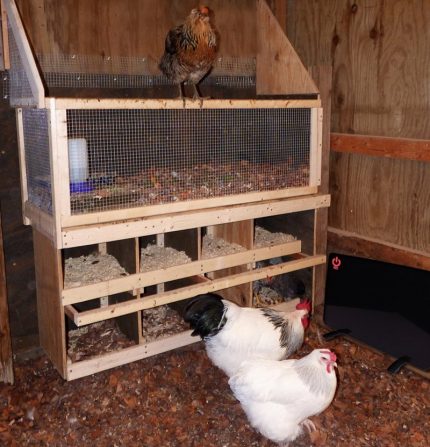
So, ventilation is divided by:
- air circulation method - natural (based on physical laws of nature) and artificial (also forced, organized with the help of various devices that require energy, in particular fans);
- purpose - exhaust, supply, supply and exhaust;
- location - zonal or general exchange.
Immediately, it should be noted that no matter what rooms or buildings the ventilation system is organized in, the equipment, devices and materials used in its design, as well as circuits, can be the same.
But each variety has its pros and cons. Therefore, considering them, it is necessary to select a ventilation network for the conditions of its operation.
We will consider different options in more detail, but first we’ll analyze what requirements are imposed.
Natural chicken coop ventilation
As mentioned above, this method works on the basis of physical laws. Warm air always rises up, and cold, on the contrary, down.
By variety is divided into:
- Unorganized - with the implementation of the process of air exchange through the window and slots.
- Organized - air is removed and flows through special channel structures.
The system cannot be based only on the removal of air, how much air is released, so much of it must enter. That is, the influx of air masses must appear from somewhere.
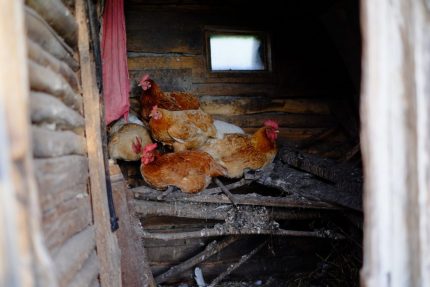
In chicken coops, these are cracks in the structure, a window leaf, a door, and so on. However, if the chicken coop is overhaul, the standard inflow will not be enough, as well as the output of the spent masses. There is stuffiness in the room. Therefore, further we will discuss precisely the organized option.
The problem is solved by inserting duct-type exhaust and inlet devices of valve type into the roof / walls of the house. Exhaust, according to the logic of physical laws, are always installed above the supply.
To organize a natural air exchange system, ventilation duct structures are designed vertically.
The main difference between natural draft and forced draft is that this ventilation can be equipped in any chicken coop in winter, since the scheme does not imply electricity and complex arrangement processes, which also makes it cheaper both from the installation and operational point of view.
But there are also disadvantages. It is completely dependent on climatic conditions on the street. That is, when the street temperature exceeds that in the room, the draft occurs in the opposite direction and, again, in still weather, the air exchange is minimal.
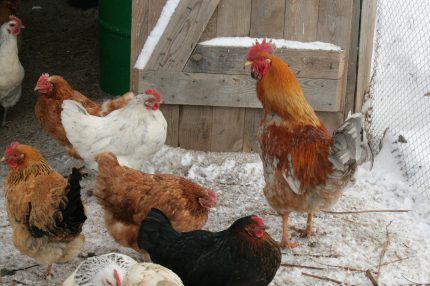
This is not of particular importance in small houses, the available circulation is usually quite sufficient, but in the case of large poultry farms, it is recommended to use a forced scheme.
Chicken Coop Exhaust Ventilation
Exhaust ventilation can be mounted without additional supply structures, but at the same time it must be organized. The air outlet occurs through the equipped channel openings in the wall or in the roof of the room. A suitable chicken coop area is approximately 10 square meters.
The positive qualities of this option include the straightforward arrangement, a very good air circulation, the possibility of increasing efficiency with the addition of some elements.
However, there are also disadvantages. You won’t be able to regulate the supply and exhaust air, the cold will penetrate into the room and of course, this system is suitable for very small houses.
The system in production is simple, it functions due to the difference in temperature conditions inside and outside the room. You only need to take care of the presence of the hood.
The role of the inflow will be performed by the door and / or window. Of course, manual control. The hood will be located under the ceiling itself, but not closer than 15 cm to it and on the wall opposite to the self-organized influx, or it will be located in the roof structure. We are considering 1 option, since in winter it is easier to organize.
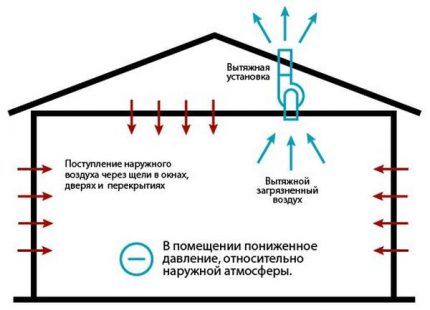
You will need a 90 ° elbow0 and a 110 mm diameter pipe. Through the knee, we bring the structure to the drilled hole on the street and then set the insulated vertical section with an elevation of 1-1.5 m above the roof level.
The joints at the location of the corner element should be foamed with mounting foam, and the pipe itself on the external wall should be fixed with clamps. A deflector must be worn on the outer end of the pipe.
Arrangement of supply and exhaust ventilation
So, you have a room of approximately 12 square meters. This system suits you as the most optimal for small houses. Consider the simplest assembly option.
Stage number 1 – ventilation design
Before you install the ventilation, you need to carefully think through everything, draw a diagram of the future design, determine the place where the pipeline will exit, develop dimensional nuances taking into account the dimensions of your chicken coop and its design features.
You can bring both pipes through the roof, as in the diagram below, you can through the walls. Installation is possible at any time of the year.
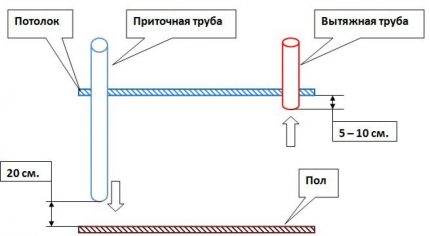
Stage number 2 - preparation of materials and tools
It is best to do this in advance, so that in the middle of the installation you will not encounter the fact that you cannot find one or another part in the stores.
You will need the following materials:
- pipes 2 pcs. - length 2 m, diameter 20 cm. It is best to choose with a circular cross section, as they create the most favorable circulation;
- insulation for pipes. You can use any suitable for outdoor installation. It is also advised to arrange a box around the pipe so that the insulation fits snugly. But if this is not possible, just tightly fix the material;
- knee - 900;
- clamps or other devices with which you can fix the pipe itself;
- deflector;
- ventilation grills 2 pcs.;
- polyurethane foam.
The set of necessary tools depends on individual factors. The main thing is that you can easily make 2 round holes in the walls of your chicken coop and somehow screw both the grilles and the pipe itself.
Definitely you will need a hacksaw for metal or a grinder, self-tapping screws (the purpose depends on the material of the building), a drill or a perforator.
Stage number 3 - install the exhaust pipe
An air duct that will discharge the exhaust air from the room is installed above the perch under the ceiling, but no closer than 15 cm to it.
To begin with, we make a hole of a suitable diameter and through it we bring out a pipe of the desired length with an angular element to the street.
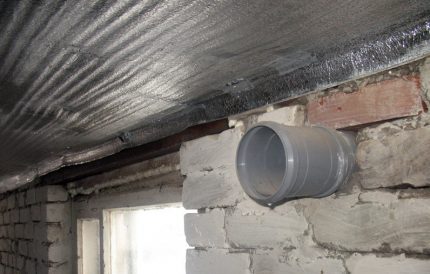
The outlet of the exhaust pipe to the roof is usually carried out at 120-170 cm.
On the street side, at the knee, experienced chicken owners advise making a small through hole. Its diameter should be approximately 5 mm and it will serve to remove condensate.
A deflector is installed on the pipe head.
Stage number 4 - install the supply pipe
It should be located on the opposite wall. For this, we also tentatively mark the location of the future pipe and drill a hole in the wall. The conclusion to the street is through the knee.
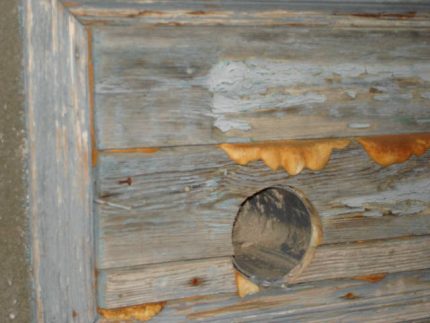
The supply pipe for the house is installed not lower than 30 cm to the floor and not less than 50 cm from the exhaust height.
It should be noted that with a gable roof of the chicken coop, it should not be higher than the horizon of the roof visor, and with a flat slope it should be 30-40 cm from the peak.
Stage number 5 - fixing pipes
In general, each pipe should be fixed immediately after installation. They must be securely locked. This will help prevent them from falling. To do this, use clamps, some kind of home-made design, or you can even use the suspensions that are used when installing the frame from drywall.
Someone makes only 1 attachment point closer to the roof near the rafters, but if there is an opportunity it is better to play it safe and do 2-3 in different places, directly in the wall of the chicken coop.
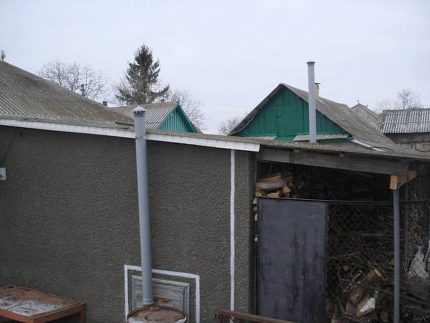
Ventilation grilles are installed on the internal pipe sections, and deflectors are installed on the ends on the street side. The dampers will help to prevent clogging of pipes and precipitation.
Stage 6 - pipe insulation
First of all, the cracks and holes around the pipes should be blown with mounting foam. For pipe insulation A huge number of different methods are used.
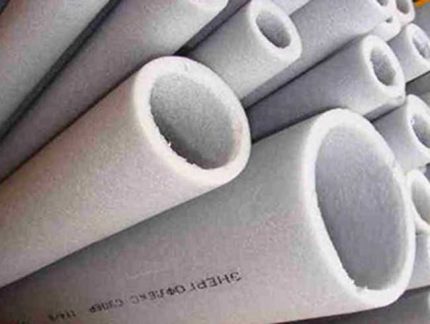
A very interesting method of pipe insulation is the "pipe in pipe" principle. In order to carry out the idea, a pipe of a larger diameter is taken.
It should be put on prepared for ventilation. Further, a heater is clogged into a pipe of a larger diameter, very tightly.
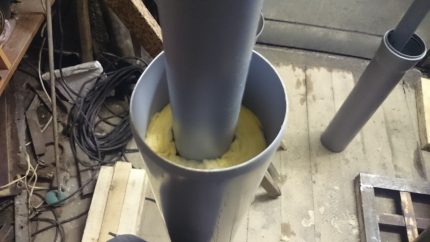
However, pipe insulation can also be done with a homemade casing. Usually, this is a wooden structure. knocked together from boards. The shape of the section here does not play a special role.
Warming is carried out either at the stage of installation of pipes, or after installation, depending on the chosen method.
Forced chicken coop ventilation
Forced ventilation is all the same channel sweeps of the supply and exhaust types, however, to increase air exchange, a fan is used and, if necessary, or optionally, additional devices, such as filters, heaters, humidifiers and so on.
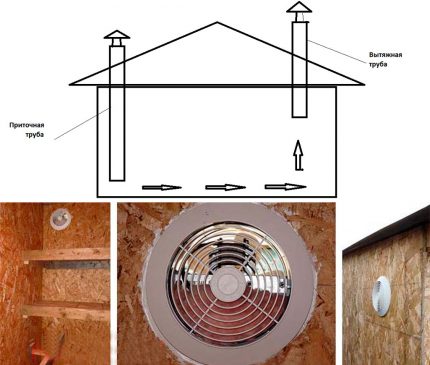
The functionality of this type of ventilation is based on the difference in the recorded pressure indicators from the street and inside the house.
It can be conditionally divided into:
- Working with reduced pressure, that is, with discharge (exhaust). This is when the air leaves the house creating a vacuum and passively sucks the outside.
- It operates at overpressure, which is often found in old poultry systems (supply). This is when the air is pumped in excess quantities and is subjected before these various processes - heating, cleaning and so on.
- Performing air exchange at equal pressure, when equipped with ventilation devices and an inlet and exhaust (combined).
- Forced ventilation has many advantages. In particular, this is the possibility of high-quality air exchange in any quadrature, with any density of birds (which is relevant in winter) and in any weather on the street.
At the same time, you can arrange a more accurate adjustment of air exchange for your engineering calculations, thanks to the selection of equipment power.
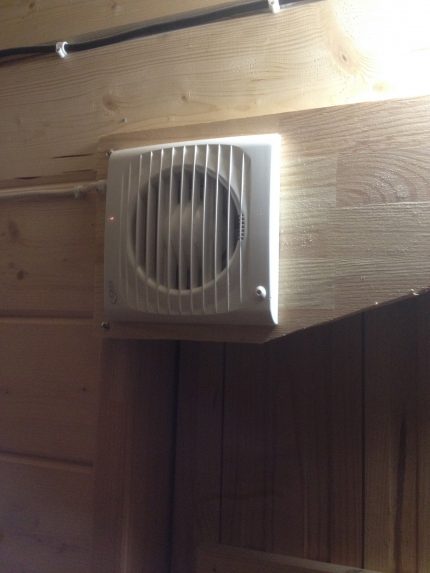
Cons, of course, are present. Among them are more expensive equipment, complicated installation, however, if you look at the scheme, anyone can handle it - the cost of paying for electricity, the labor for maintaining the system.
Fans and methods of their location
The first definition that you will encounter when installing an artificial ventilation system is a fan.
The main varieties of this unit used in the arrangement of the air duct system:
- Axial - the most common type, characterized by high efficiency and the simplest structural assembly.
- Diagonal - the device is somewhat similar to axial, but their main difference is that they send the air flow in a diagonal direction, which significantly reduces their noise during operation.
- Diametric - have blades with a bend up. They have high aerodynamic abilities and, as a rule, they are rarely used for chicken coops.
- Direct-flow - they do not have "wings", for this they are also called bezlopastny. Their advantage is the ability to pump large volumes of oxygen and precise flow direction.
- Direct-flow turbines pump air through frames of a special design. Such devices pump large volumes of oxygen and allow you to direct flows in the right direction.
You will also hear concepts such as channel and roof fans. But everything is simple. Ducts are installed in ducts, and roof in roof structures.
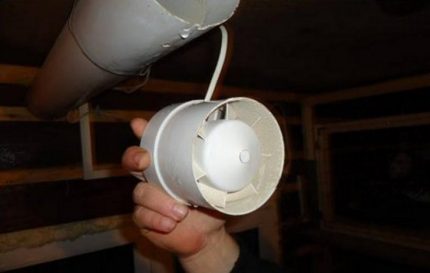
Unfortunately, providing artificial ventilation is best in the summer, and even better at the design stage of the building. Moreover, the arrangement of holes in the main walls and electrical wiring will be required. Although simple schemes in stagnant, most “dry” winter weather are quite feasible in implementation.
The system in geometry can be of several types. Let's talk about the varieties of forced briefly and later in more detail about some specific schemes.
Roof ventilation - when exhaust ventilation ducts are arranged in the roof ceilings or in the end area of the room, and exhaust ventilation in walls and in the roof (there may be one option).
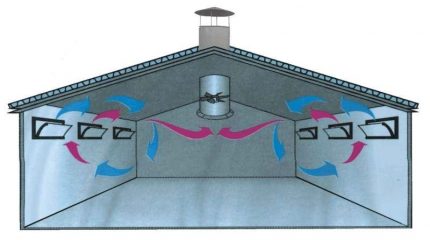
Cross ventilation involves placing fans on the same side of the house to extract exhaust air. And the influx comes from the opposite side through valves. It is mandatory to have an automatic control station that allows you to control and set the high-speed mode of rotation of the fans. Devices usually have little power.
This option is installed in houses with several floors, but it is not popular, because in winter you have to use all the fans to achieve optimal microclimate indicators, otherwise “dead” zones are created, and in the summer such an arrangement does not allow to properly ventilate the room.
The longitudinal one is similar to the transverse one in principle, however, the fans are installed on the end area of the room when air exchange is necessary along the building. Units of higher power are used here than in the transverse one.
Tunnel ventilation differs from the longitudinal arrangement of the blinds on the wall opposite from the fans. In other words, the air in it moves as if through a tunnel. The basis of the system’s functionality is convection cooling of air masses, which is formed due to the high flow rate moving at the level of the birds.
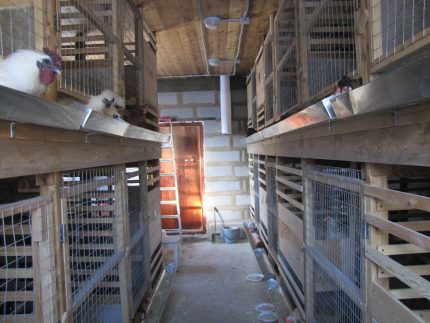
There are many schemes, you only need to make a choice and take into account that it is best to think about ventilation of a large-sized house during its development, that is, design, excluding the simplest options.
In the meantime, we will consider only the simplest, because other species are being developed at large poultry farms.
The simplest ventilation
Do not think that all schemes are complex. For small chicken coops, you can use the simplest options. The main thing is that they can provide air exchange with a calculation of 6 m3 for each kg of weight of available chickens. Of course, approximately, ideally accurate calculations are not necessary.
The principle of constructing a channel system is the same as in the case of natural supply and exhaust ventilation. All two opposite pipes are also installed at different levels. The only thing in the design is a fan.
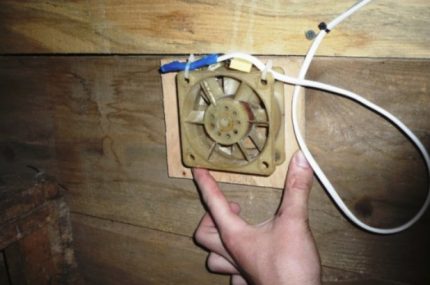
The system is equipped with a switch. Moreover, it is best not to connect it to the lighting, as many do, in order to be able to control the system at any time. In principle, it is enough to turn on the fan for only 3-4 hours a day.
Additionally, if desired, the system is equipped with humidity and temperature sensors. This provides the simplest process automation.
And of course, do not forget to equip the vertical heads ventilation ducts deflectors. This is mandatory for any type of ventilation arrangement.
Material selection and options
Different types of mechanical ventilation schemes of various types may be present, with a purpose not always clear to a typical farmer.
We will analyze some of them.
- Filters Devices that trap debris and / or harmful airborne contaminants from the street. Or they also help clean the air coming out of the chicken coop.
- Heating elements. Everything is clear here. These are devices that contribute to the possibility of increasing the temperature in the house mechanically.
- Recuperator- mixes air, street and leaving the room, forming a uniform warm mass.
- Sound attenuation - devices or structures that help to eliminate noise from fans or reduce them. Usually installed on large farms and factories.
- Autocontrol system - controls all automated processes.
These are only the basic basic elements that are most often used for ventilating rooms with chickens and other poultry.
At very large enterprises, other high-tech devices may also be present.
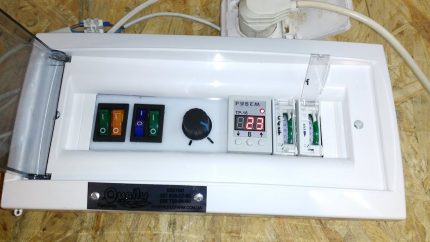
As for the choice of materials, it is necessary to approach the issue responsibly, since the durability of your design and the frequency of repair intervals depend on their quality.
Ducts - features of choice
It is very important to choose the right ducts.
The main selection criteria should include:
- tightness and durability;
- the possibility of arranging thermal insulation and, preferably, sound insulation;
- absolutely smooth internal structure.
Ducts can be plastic or metal.
Metal pipes made of galvanized or stainless steel are quite strong and durable in operation. But usually they are used for large objects.
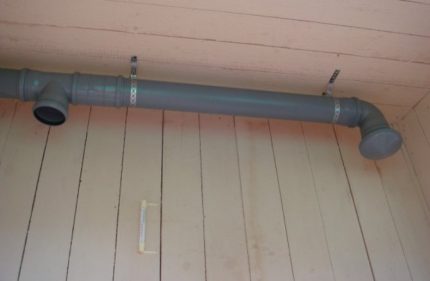
As for plastic pipes, their budget and ease of installation are advantageous precisely for the arrangement of houses. They are made from durable polypropylene mass.
They do not rust, they look quite aesthetically pleasing and, in addition, provide good air flow and better sound insulation, in comparison with metal ones.
More information about the types of ventilation ducts and the features of their installation can be found in this stuff.
The nuances of arrangement in the winter
In winter, depending on the weather, you can arrange almost any method of air exchange in the house. Including it is possible to arrange both ventilation in the chicken coop in winter according to the scheme without electricity, and with its use.
The main thing, when using a power tool and when installing electrical wiring on forced systems, is to observe the safety precautions for working in a humid environment. And besides, when deriving roof-type structures, be careful in high-altitude work.
In addition, it is very important to identify the hens somewhere during installation, so that they do not breathe dust during the installation of openings for appliances and do not freeze from drafts.
When planning the ventilation system, it is very important to consider that the supply ventilation is a cooler. The exhaust pipes and air inlets are located as far apart as possible, usually on opposing surfaces.
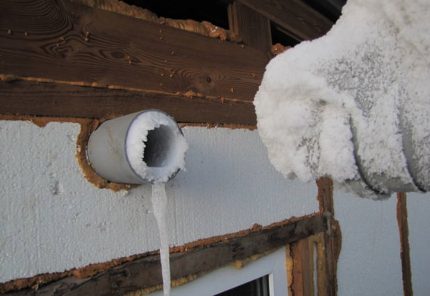
Another very important nuance - do not forget to periodically check the draft and inspect / clean the entire ventilation system.
In addition, none, even the most effective ventilation, can cope if you do not, as necessary, clean the chicken coop from litter and change the litter to fresh.
Conclusions and useful video on the topic
Video number 1. One of the options for arranging chicken coop ventilation:
Video number 2. Coop ventilation from plastic pipes:
Thus, we examined different schemes of effective winter ventilation in the chicken coop with our own hands. Some of them are available for arrangement in any case, others should be selected based on the design possibilities of installation in a particular building and precisely in the cold season, everything is individual here. But you can definitely install simple natural extraction / inflow mechanisms.
Have you ever had to deal with the arrangement of ventilation in the chicken coop? Please tell our readers how ventilation works in your house. Share your experience or ask interesting questions on the topic in the comments.

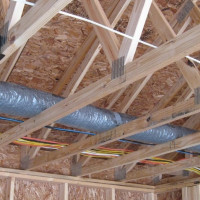 Ventilation in the house from sip panels: the best options and layouts
Ventilation in the house from sip panels: the best options and layouts 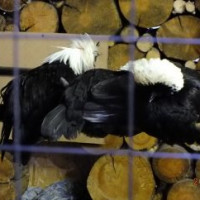 Hood in the chicken house: the best ways to equip the ventilation system in the house
Hood in the chicken house: the best ways to equip the ventilation system in the house 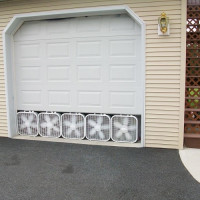 DIY garage ventilation: an overview of the best options for arranging an air exchange system
DIY garage ventilation: an overview of the best options for arranging an air exchange system 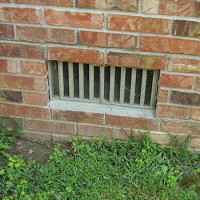 Forced ventilation in the cellar: rules and arrangements
Forced ventilation in the cellar: rules and arrangements  Air exchange in dentistry: norms and subtleties of arranging ventilation in a dental office
Air exchange in dentistry: norms and subtleties of arranging ventilation in a dental office  Ventilation and air conditioning for medical institutions: rules and features of the arrangement of ventilation
Ventilation and air conditioning for medical institutions: rules and features of the arrangement of ventilation  How much does it cost to connect gas to a private house: the price of organizing gas supply
How much does it cost to connect gas to a private house: the price of organizing gas supply  The best washing machines with dryer: model rating and customer tips
The best washing machines with dryer: model rating and customer tips  What is the color temperature of light and the nuances of choosing the temperature of the lamps to suit your needs
What is the color temperature of light and the nuances of choosing the temperature of the lamps to suit your needs  Replacement of a geyser in an apartment: replacement paperwork + basic norms and requirements
Replacement of a geyser in an apartment: replacement paperwork + basic norms and requirements